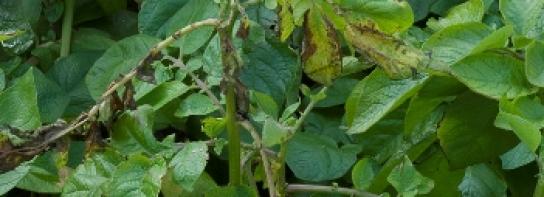An AHDB Seed Potatoes Event workshop report
A disease on the increase?
In the context of disease incidence reporting, exponentially increasing graphs are never a good thing! Fortunately my concerns were somewhat allayed when Gerry Saddler of SASA pointed out that the seemingly rocketing levels of Blackleg were as much to do with a change in the reporting system as a ‘real world’ increase. We can argue (and we did) over how serious the problem is but, in my view, that’s not really the point. The point is, it’s there, it’s increasing and the sooner we get on top of it, the better it will be for all of us.
Cleaner seed stocks
There are many angles from which we can tackle the disease, starting with the quality and age of seed stocks. The maximum age of seed stocks has just recently been reduced to FG7 in High Grade Areas and FG9 in most of England and Wales. Some were in favour of radically reducing the number of field generations further, down to 4. From a blackleg perspective, I can see this makes sense, but I suggest that this needs to be balanced against the costs of development; it takes a considerable amount of time and money to get seed into the system and therefore the longer you can grow them for, the more crops you can spread that cost over. My own crops were between FG 6 and 8 and I haven’t had any problems to speak of. I get the point, but perhaps 4 is a little extreme?
More inspections
Increasing the number of field inspections was one of the more controversial suggestions. Some were of the opinion that inspections had an important role to play, and the proof was in the number of downgrades (voluntary or otherwise) due to blackleg at a third inspection. Others felt that third inspection for PreBasic seed had been around for many years and that fact that blackleg was still increasing called into question their efficacy. Among producers, at any rate, the jury is clearly still out.
Haulm removal
Ian Toth, at the James Hutton Institute showed that a discontinuation of sulphuric acid as a haulm desiccant could have resulted in an increase in the incidence of blackleg. As an organic producer, I will not mourn its passing but it did make me wonder whether I should burn off my haulms with gas rather than just cutting them off and leaving them in the field – and whether it would have other benefits besides black leg management.
Post harvest
There is much that can be done post-harvest. Grader hygiene is essential and good ventilation is vital and ‘tent blowing’ where a the ‘tent’ sits on top of the boxes and sucks cool dry air through the potatoes can help.
Tony Little
Photo credit: SASA
RELATED LINKS
Conference presentations
Other conference blogs

